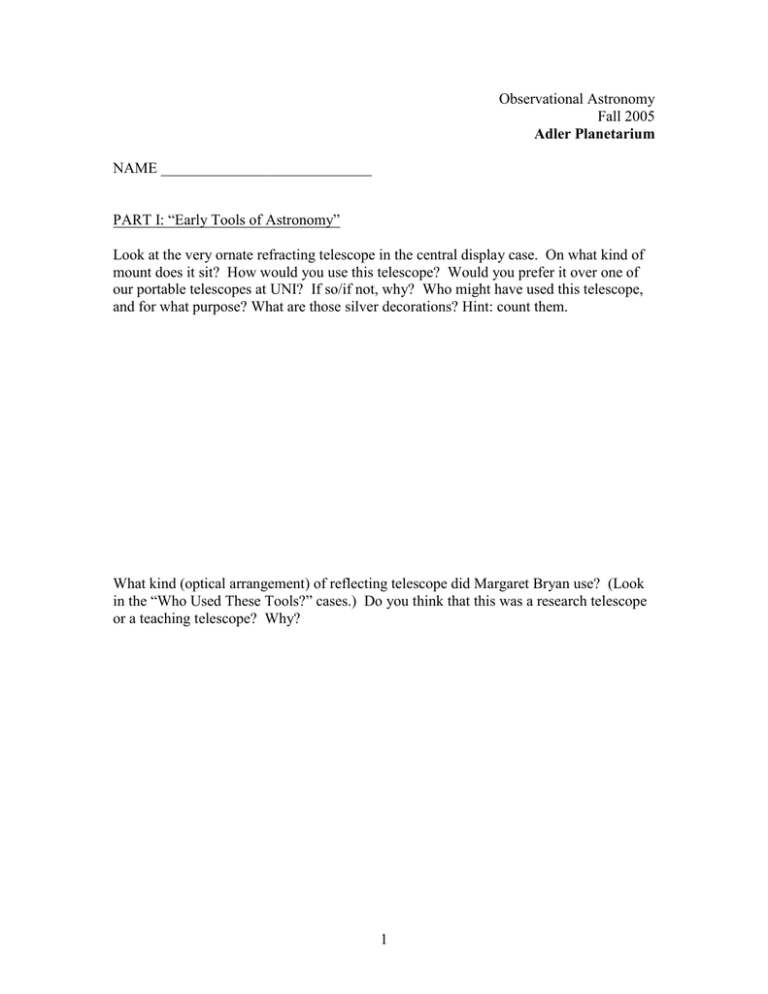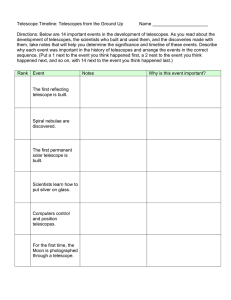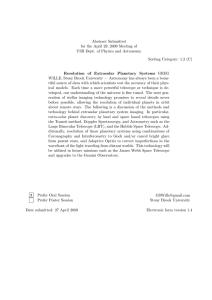Observational Astronomy Fall 2005 NAME ____________________________
advertisement

Observational Astronomy Fall 2005 Adler Planetarium NAME ____________________________ PART I: “Early Tools of Astronomy” Look at the very ornate refracting telescope in the central display case. On what kind of mount does it sit? How would you use this telescope? Would you prefer it over one of our portable telescopes at UNI? If so/if not, why? Who might have used this telescope, and for what purpose? What are those silver decorations? Hint: count them. What kind (optical arrangement) of reflecting telescope did Margaret Bryan use? (Look in the “Who Used These Tools?” cases.) Do you think that this was a research telescope or a teaching telescope? Why? 1 How do you hold an astrolabe in order to use it? (You might want to include a rough sketch.) What is at the center of an armillary sphere? Why do you think this object chosen to be the center? To what are the two axes of an armillary sphere parallel and perpendicular? Where on the celestial sphere would it be most difficult to point the armillary sphere? (This is true of certain telescopes, too!) How do you use a quadrant? Why is it called this? What might be the difficulty with using a quadrant (or sextant) aboard ship, for purposes of navigation? 2 “Welcome to University!” Why does the sundial in the medieval classroom appear to be backwards? In what direction does the window in the medieval classroom face? Find an object in the medieval classroom used to keep time. 3 PART II: “Sundials – Using the Sun to Find the Time” What is a gnomon? Why are there so many kinds of sundials? Which one intrigues you? Why? What is a nocturnal? Where is the large sundial designed to be used? 4 “Muslims Watched the Sky” What is the altitude of the Sun, as seen from Isfahan, Iran, at noon, on 18 April? In what units are astrolabes typically marked? What is an alidade? What is a rete? What two times of day can an astrolabe indicate that a regular clock cannot? How might that help explain why astrolabes are so important in the Islamic world? 5 PART III: “From the Night Sky to the Big Bang” At what rate must the Earth move in the large orrery (“A Universe of Planets”) so that all the objects connected to it by gears will move at exactly 1/10th their real angular speed? Be very specific; use appropriate units. What changes had to be made to this orrery when the British adopted the Gregorian calendar in 1752? What is the Georgium Sidus on the outer ring? What kind of lenses did Galileo Galilei’s refracting telescope use? Estimate the largest possible focal length that the object of this telescope might have. Why? 6 How is William Herschel using his eyepiece to image light coming from the objective in his reflecting telescope? Why might he be doing it this way? Do you think that the focal length of his eyepiece is very long? Why or why not? What can you say about the exit pupil of Herschel’s telescope? Make a technical description of the Dearborn Telescope. Be sure to include its exact type, aperture, and mounting style. Assuming a 100mm focal-length eyepiece, suggest an approximate magnification for this telescope. (This is an approximation, so don’t get carried away with significant figures in your calculation!) Describe how you went about making this estimate. Listen to “Edwin Hubble” describe his telescope. How much more light would this Mount Wilson telescope gather than the human eye? (Assume a human pupil diameter of 5mm.) Why do you think the telescope is on Mount Wilson, and not at Carnegie Institution headquarters in Washington, DC? 7 We try to keep our telescopes at the same temperature as the surrounding air (“Getting a Better Snapshot”). Is this an important consideration for the Far Infrared Survey Experiment telescope? Still, the FISE-telescope designers went to a great deal of trouble to keep the instrument cold. Why? What is the difference between an astrolabe and an armillary sphere? (Hint: Look near the “Atwood Sphere.”) Go upstairs! Find the models of the SOFIA airborne telescope and Greenbank radio telescope. Compare their theoretical angular resolutions. Show your computations. 8


